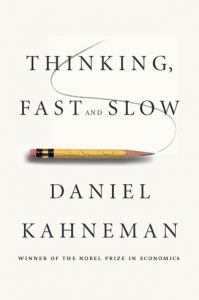What we’re reading: Thinking, Fast & Slow.
By Caroline Kryder
My copy of Thinking, Fast & Slow has survived the abuse of countless coffee stains, an onslaught of dog-earing and more than one close scare with a bath tub. I all but slept with the book under my pillow while completing my undergraduate thesis on emotional responses to political advertisements and can’t recommend it enough.
A New Wave of Irrational Consumers
Conventional wisdom surrounding advertising assumes that consumers are rational decision makers who can be persuaded by the right creative. A new school of thought is quickly emerging, however, that is replacing the importance of being ‘on message’ with being ‘on emotion.’
At the heart of this shift are advances in our understanding of the brain which demonstrate that emotion is the driving force behind decision making rather than an isolated process within our minds. The leading expert behind this change is Nobel Prize winner and behavioral economist, Daniel Kahneman who summarizes his celebrated work in his recent book Thinking, Fast & Slow.

The foundation of his research is that humans have a limited amount of cognitive resources with which to process information. If we acted solely as rational decision makers, we would exhaust these resources and fail to respond to our environment efficiently. As a result, our brains have evolved two systems: a primary ‘system 1’ that is fast, automatic, emotional, and subconscious; and a secondary, infrequent ‘system 2’ that is slow, logical, effortful, and conscious. These systems work in tandem to facilitate decision making by relying heavily on emotional cues to prioritize information. System 1 is responsible for forming initial impressions that are solidified into beliefs. Only when system 1 fails to come to a decision is system 2 called for backup in the form of exhaustive rational thought.
While this emotionally-driven arrangement has helped humans survive primitive dangers, in today’s world these quick heuristics and biases lead us to make systematic errors. Kahneman’s book identifies each of these errors in turn and provides the perfect opportunity for advertisers to understand the new model of irrational consumers and the importance of system 1 in consumer decision-making.
More Insights
- July 28, 2015 Milwaukee Lion Watch
- July 27, 2015 Google’s take on Generic Top Level Domains.
- July 22, 2015 Be careful with your pretty pet (or, what to do with Instagram advertising)
